Located 15 kilometres to the west of Tours, Villandry is a Renaissance estate and castle best known for its beautiful formal gardens made up of endless geometric parterres edged in carefully manicured and clipped boxwood.
Situation Map of Villandry
Villandry contains one of the last of the great Renaissance chateaux built in the Loire Valley and today attracts more than 350,000 visitors per year who come here to admire the beautiful, diverse and harmonious estate’s fine setting.
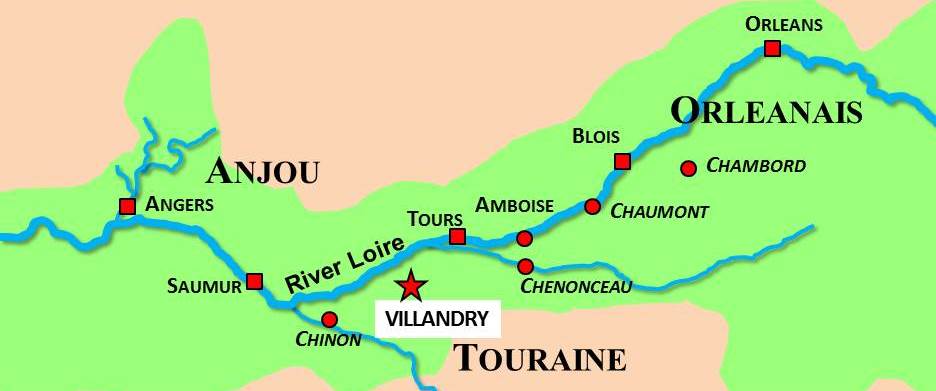
Villandry: a bit of history
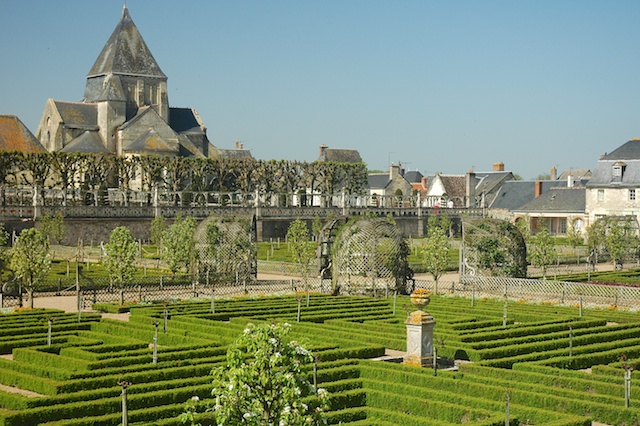
In the middle ages, a fortress named “Colombiers” (Dove Roosts) occupied the site of the present day chateau. On 4 July 1189, Henry II, King of England, acknowledged his defeat to Philip Augustus in Colombiers. The French king, a master strategist, had demanded to meet the Plantagenet there after having defeated him at the battle of Azay-le-Rideau earlier that year.
The resulting peace treaty confirmed the victory of the Capetian monarchy’s authority over the feudal lords, particularly the Plantagenets whose lands covered a large area in today’s France: Normandy, Brittany, Maine, Touraine, Anjou, Poitou and Aquitaine.
The fortress and its domain were successively occupied by the Craon and Chabot families in the 14th century before being bought in 1532 by Jean le Breton, Minister of Finances under King François I. Le Breton decided to dismantle the fortress except for the squared keep on the south-west side of the site. At the foot of the keep, behind the great courtyard, it is still possible to determine the position of the fortress’ foundations.
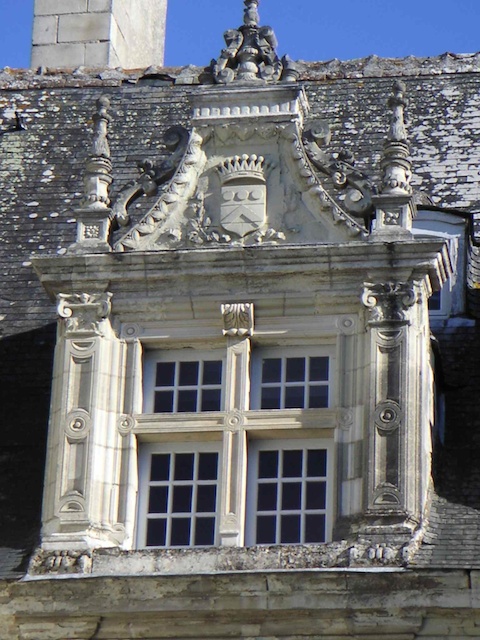
Jean le Breton had gained exceptional architectural experience by working as the construction manager for the chateau of Chambord for many years. The new chateau, completed in 1536, was designed in two large L-shaped wings featuring the typical elements of the Renaissance style: large windows framed by pilasters topped with capitals in classical style, horizontal moldings, and on the roof, large dormer windows decorated with superstructures comprising pediments and volutes.
Because this castle did not need any defensive features, the courtyard entrance is open to the outside and not enclosed by the main body of the building. Villandry was built as a welcoming residence overlooking the River Cher which flows nearby.
The new château bears some resemblance to Villesavin Castle near Chambord, which was built by Le Breton as a smaller model of Villandry.
The statesman was given the role of French Ambassador to Italy and devoted his spare time to studying the landscape design of Italian Renaissance gardens. Naturally, he used this knowledge to lay-out the gardens of Villandry.
Finding the name of the place too common, he wished to change it, as well as his own name. Being in favour with King Francois I, the king allowed him to be called “Monsieur de Villandry”.
Le Breton spent his entire fortune on Villandry. The construction of a new Renaissance chateau, the laying out of gardens in the Italianate fashion and the changing of the name to Villandry meant a lot as it conferred on his family important social standing.
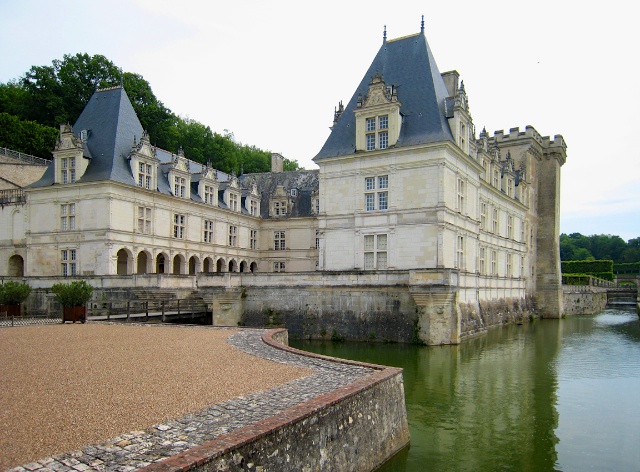
After being held by Jean le Breton’s family for two centuries, Villandry Castle then changed hands many times, its value often underestimated.
In 1754, Villandry Castle was acquired by Marquis Michel-Ange of Castellane (1703-1782), Brigadier of the King’s Armies and Ambassador under Louis XV to the Ottoman Empire from 1741 to 1747. Born into one of the oldest and most illustrious families of Provençal nobility, the Marquis acquired Villandry in 1754. Four years later, Villandry was bestowed with the title of ‘County’ by royal decree.
The Count added the pavilions which flank the entrance as well as outbuildings à la Mansart.
Castellane found the Renaissance castle cold and uncomfortable. He renovated the interior of the castle to adapt it to the standards of comfort of the 18th century. For example, he installed wood panelling for soundproofing and thermal insulation.
New elements of decoration were added such as a Louis XV style staircase with a wrought-iron balustrade on which can be seen the intertwined initials of Michel-Ange of Castellane.
In order to improve the exterior features of the castle, several trompe-l’œil windows were painted. The Count also added balconies, bridges and pavilions. These renovations somewhat deformed the façade and the Renaissance castle lost some of its appeal.
As for the gardens, they were enlarged with the addition of new grounds bought by the Count in 1760. Then a new lay-out was undertaken in the formal French style. Decorative features were added such as an ornamental lake, flower beds, orangeries, and terraces.
The Marquis of Castellane died at Villandry on 26 September 1782 and was buried in the seigneurial vault in the parish church of Villandry. His son, Esprit-François-Henri chose to move to Paris and sold the estate of Villandry to François Chénais, a rich slave trader from Nantes. The castle was sold again to Gabriel Julien Ouvrard for 350,000 francs. The new buyer could not pay the balance of the agreed price which resulted in Napoleon I paying the 60,000 francs owing to acquire the estate. The Emperor then gave it to Jérôme Bonaparte, his younger brother. In 1810-1811, following an arrangement between the Bonapartes and their creditors, Villandry was handed over to the Hainguerlots, a family of bankers.
The Hainguerlots sold Villandry in 1897 to new landlords whose intention was to dismantle the castle in order to sell its stone. Their plan did not eventuate and the estate was once again sold to François-Pierre Le Roux, a physics professor and chemist. Because he was unable to afford the expenses involved in the maintenance of the castle, Le Roux tried with difficulty to sell Villandry, and its value was considerably underestimated.

In 1906, two days before his death, Le Roux managed to sell the estate to Doctor Joachim Carvallo, the husband of a rich American steelworker’s heiress. The new owner played an important role in the history of the castle as he dedicated his life to Villandry, giving up a brilliant scientific career. By buying the estate, he saved the castle from being dismantled and promised to return Villandry to its former glory. The gardens were restored to match the Renaissance style of the castle and Carvallo’s collection of fine Spanish paintings were installed there, as recorded by P. Le Noach in ‘Histoire de Villandry et de son Château’ (1949):
“The effect of the initial renovations was amazing. In less than a week, Villandry had regained its Renaissance character. I invited the members of the Touraine Archeology Society to come and witness the work I had carried out. These gentlemen, who were accustomed to seeing Villandry covered in false windows, which gave it the gloomy, monotonous appearance of a barracks, were filled with wonder; they couldn’t believe their eyes and thought that, with the wave of a magic wand, I had built a new chateau.”
Carvallo decided to open Villandry to the general public and in 1934 arranged for it to be listed in the inventory of French Historical Monuments. In 1924, Carvallo founded the “Demeure Historique” association, the first of its kind to represent the owners of listed historical monuments. The Association is still in existence today.
A native from Spain who emigrated to France in 1893, Doctor Carvallo was the great grand father of the current owners.
The Gardens of Villandry
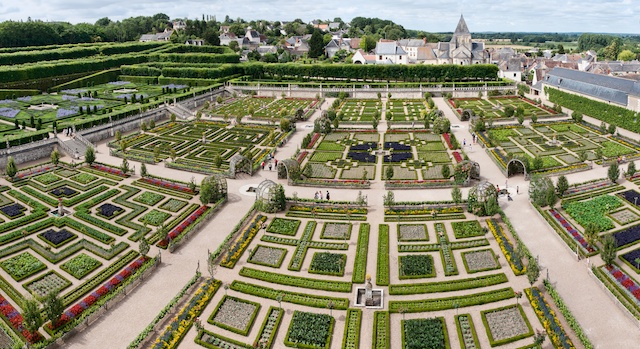
When Joachim Carvallo acquired the estate of Villandry, he committed himself to restoring the gardens to their former glory. From 1907, the new owner undertook extensive research, studying old documents. He found his inspiration in the Renaissance era but was careful not to select any one given model of garden. He designed each one of the gardens separately as a succession of courtyards arranged one next to the other.
Carvallo and his two fellow Spaniards started the immense design work: the trees from the original garden were isolated and the moats cleared out to set out the general shape of the terraces and the great pond.
The gardens were laid out in formal patterns separated with low box hedges. Paths intersecting at right angles ran along the lower beds where low borders set off the decorative plants. A perfect geometric masterpiece was arranged in three tiers of terraced gardens:
The decorative kitchen garden
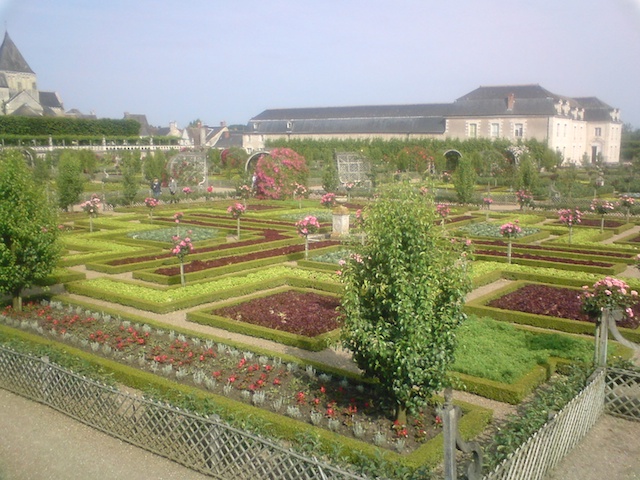
This part of the lower garden covers almost a hectare and is comprised of 9 square sections divided into beds of plants which shows a variety of colours from hundreds of flowers and vegetables. The tradition of kitchen gardens dates back to the Middle Ages when monks cultivated them in geometric shapes to provide food for the occupants of the abbey. The vegetable garden was created during the First World War to feed the hospitalised patients who stayed in the castle. Today, the vegetables and flowers serve only a decorative purpose and their plantings are renewed twice a year, in spring and in summer. Autumn is the best season to admire the crimson colour of the cabbages mixed with the orange of the pumpkins, or the blue of the leeks.
The pleasure garden
This is the ornamental flower garden set in the middle terrace where the castle stands.
The first four box hedges (Premier Salon) are used to evoke one of the allegories of love. Specific colours are intended to emphasise the powerful feeling of love:
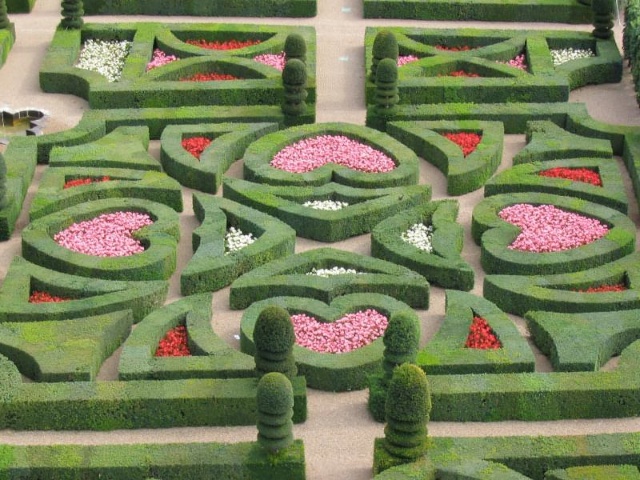
- l’amour tendre (tender love) with hearts and masks (orange),
- l’amour passionné (passionate love) with bleeding hearts,
- l’amour volage (fickle love) with horns and fans (yellow), and
- l’amour tragique (tragic love) with knife blades (red).
A canal separates the Premier from the Second Salons, the “Music Garden” which obviously refers to music with large triangles symbolising lyres and with bushes evoking harps.
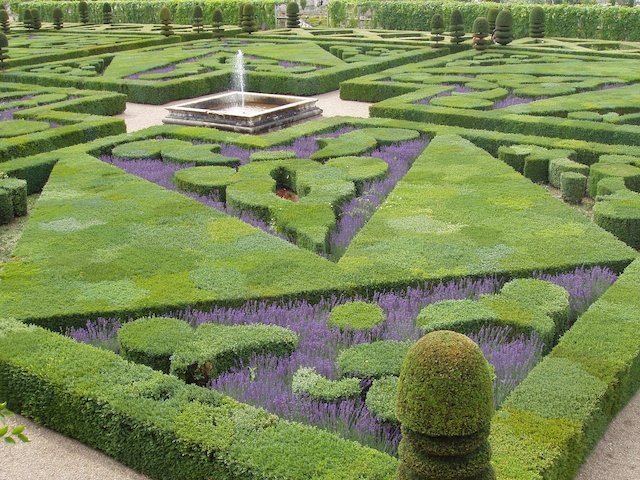
Adjacent to the Music Garden lies a garden of shapes representing the Maltese cross, the Basque cross, the Languedoc cross along with the fleurs de lys, the royal emblem.
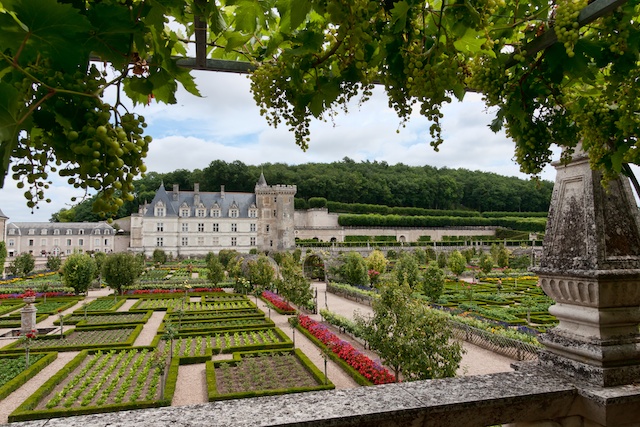
To enjoy a fine view of the entire flower garden, it is best to stroll through the elevated walkway (le belvédère) located between the castle and the gardens.
Another garden on the second level is the herb garden, which completes the site and contains medicinal and aromatic plants and the vegetal maze, where young and old alike love to lose themselves.
The water garden

The third parcel is located on the highest level where a vast ornamental pond collects water necessary for the irrigation of the canals and gardens and the supply of the fountains. This is by far the most peaceful site on the estate with its edges bordered by arbors, the pond, several fountains, beautiful lime trees and great spaces of lawn.
Find out more about the castle and gardens of Villandry through the official website: http://www.chateauvillandry.fr
Featured image: Villandry © Craig Rettig




